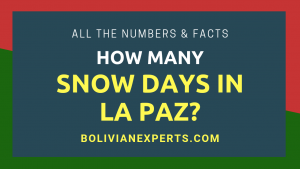Contrary to what most foreigners think, Bolivia is not only a very elevated over the sea level altiplanic country, in fact, most of the country is tropical like Brazil. However, Bolivia has also a corridor of mountains that cross the country from North to South and has a very rugged terrain. It’s also remarkable the Chaco region to the south.
Bolivia is divided into 3 very different major geographical regions. The Altiplano to the west, a very elevated (13,000 ft amsl, 4000 m) endless flat land in all directions. The central chain of mountains and valleys that divides the country, very rugged. The tropical endless flat lands to the east.
Here we’ll be talking about the geographical nature of Bolivia, its main geographic regions, the main features of each one, and how they differ from each other. You’ll know every detail about the cold and flat Altiplano, the tropical and Amazonian lands, and the rugged central region of Bolivia, as well as the dried flat Chaco in the country’s south.
Bolivia is divided into 3 main geographical regions
What happens in Bolivia is that it’s crossed almost at its center by the Los Andes mountain range. This mountain chain divides the country between the East and the West. Making these 2 regions of Bolivia completely different from each other in their geography.
Furthermore, on the slopes of the Los Andes mountain range, a central corridor that crosses the country from North to South, which is very rugged and full of valleys, hills, canyons, and smaller mountains, is present. This corridor is the transition between the warm East and the cold West of the country.
As a result of this, Bolivia is almost equally divided into 3 very different regions regarding their geography:
- The altiplanic cold high elevated flat lands, at the west.
- The central corridor of tempered valleys, mountains, hills, and canyons.
- The tropical warm low-elevated flat lands, at the east.
Each of these 3 regions occupies a significant amount of territory in Bolivia, the Altiplano gets about 28%, the central corridor of valleys and hills about 13%, and the tropical lands about 59%. Then, Bolivia is mostly a tropical country, but the Altiplano is also a big part of it. Additionally, as for being a transition between these 2 regions, the central rugged corridor is significantly smaller.
These 3 regions differ a lot in:
- The average altitude of their lands (from 400 ft amsl or 100 m in the tropical lands, to up to 16,500 ft amsl 5,500 m in the Altiplano).
- How rugged their lands are (from endless flat lands in both the west and the east to interminable valleys, mountains, hills, canyons, and plateaus in the central corridor).
- The amount and complexity of their lakes and rivers. (From very simple, with few lakes and narrow rivers in the Altiplano, to really complex, with very wide rivers and many lakes in the tropical lands and the central corridor).
- Their climates and temperatures (from almost freezing temperatures in the Altiplano to temperatures above the body heat level in the tropical lands).
- Their average rainfall (from little rainfall throughout the year in the Altiplano to almost Amazonian rain storms in the tropical lands).
- Their flora and fauna (from almost no wildlife in the Altiplano to very complex flora and fauna of all types in the tropical lands and the central corridor).
- The people’s culture and way of living (very differentiated: the Collas in the Altiplano, the Cochalos in the central corridor, and the Cambas in the tropical lands).
Now let’s see these 3 geographical regions of Bolivia in a lot more detail.
1) The highly elevated flat lands (Altiplano) in the west
This part of Bolivia is flat, and very elevated over the sea level. It’s an arid land that was formed because a tectonic plate got trapped in between other colliding 2 plates, so this triggered this plate to turn more and more elevated throughout time.
A highly elevated flat land everywhere (Altiplano)
The Altiplano means “elevated flat” so this land honors its name. While being there you’ll usually see an endless flat land in all directions. It’s not like in other very high elevated terrains around the world e.j. The Alps, where you’re not going to find flat endless lands around you.
Rather than this, you’ll see that the Altiplano seems to be endless in all directions to the horizon. It’s also a pretty arid land located at a very high altitude (about 13,100 ft a.s.l. or 4000 m), where foreigners usually suffer because of the lack of oxygen. Anyway, about 3 million people currently live there, in 4 major cities, La Paz, El Alto, Oruro, and Potosí.
The Los Andes Mountains chain encircles the Altiplano
This mountain range splits itself between 2 large branches that encircle the plain high elevated land called Altiplano, it’s like a dried giant lake with its boundaries being these 2 branches of the Los Andes mountain range. Indeed, this lake was a reality in prehistoric times, and it shaped the current flatness of the Altiplano.
Then, what you are going to see nowadays is a very flat dried elevated land that seems to be endless, with its boundaries actually being these 2 branches of the Los Andes mountain chain. Within the Altiplano lands you can also find some other minor and small hill chains.
Very elevated snowy peaks in this mountain range
As we just said 2 branches of the Los Andes mountain chain encircle the Altiplano, but some of these mountains there can reach very high altitudes above 19,600 ft amsl (6,000 m). These peaks tend to have a lot of snow and some are continually visited by climbers and hikers. A few of these peaks are easy to climb, but the majority are really dangerous, be careful with this.
There you can find some famous and also quite dangerous mountains. We have for example the Illimani that can be seen from La Paz city, and is pretty risky to climb, another one is the Illampu, which is very risky to climb. Be careful in all these mountains, just months ago we heard about tourists who died trying to climb some of these peaks.
Two Salt flats, the Uyuni’s Salt flat, and Coipasa’s Salt flat
By far, the most famous tourist attraction of Bolivia, the Uyuni’s Salt Flat is located within the Altiplano, on its south side. When you are in the middle of this salt flat, it’s like a white sea around you that reflects the sky at night. It’s the largest salt flat in the world, but there is another one a lot less known, at about 75 miles (120 km) away, the Coipasa’s Salt Flat.
This second salt flat it’s not really known nor visited by too many tourists. Be careful to pick the right agency to go to the Coipasa’s Salt flat, as it has less infrastructure around it, and almost nobody lives there.
Two large lakes, the Titicaca Lake and Poopó Lake
The Titicaca Lake is well known by tourists and is usually visited through 2 major towns, Copacabana and Desaguadero, it’s also within the Altiplano on its northwest side. This is a very large lake, which has some interesting islands inside, like the Sun’s and Moon’s islands, often visited by tourists.
Until recent times there was also another lake, the Poopó Lake, right at the center of the Altiplano, but it just disappeared due to climatic changes and global warming. Instead, in its place there is now a tiny lagoon that continues to dry. Be Careful when visiting this place, there is nothing to see there and it’s quite empty and risky.
A major river that connects both lakes
There is also a major river connecting both Titicaca and Poopó lakes, but lately, this river has become drier and drier, mostly due to the intensive use that local communities make over its waters, so it starts pretty wide but it ultimately disappears somewhere within the Altiplano flat lands.
This river was at one time the main water source for the Poopó lake and in the past it even reached the ocean, but nowadays it doesn’t go too far.
Significant volcanic activity and volcanoes
On the south side of the Altiplano, there is a complex of many volcanoes and permanent volcanic activity. The place is a protected area and is called the Eduardo Avaroa National Park, and it’s heavily visited by tourists. It’s also a side destination of the Uyuni’s Salt Flat, as it’s very near to it.
The part of the Altiplano region where this volcanic complex is located is even at a higher elevation of about 16,400 ft amsl (5,000 m), but it’s still a flat land that seems to be endless with some volcanoes or groups of volcanoes, geysers, and very interesting rock formations around.
Indeed, these lands are so interesting that some people call them landscapes from another world. There you also can find the Red and Green Lagoons, extremely dried deserts, like the Siloli and Dali deserts, the Sol de la Mañana geysers, the Licancabur volcano, the Stone Tree, etcetera. It’s definitely a place worth visiting.
Small deserts are present there
In this part of the Altiplano, the south side, within the Eduardo Avaroa National Park, you can also find extremely 2 dried and small deserts, which can be compared to the Atacama desert. The Dalí’s desert and the Siloli Desert.
The Dali desert is very small, with about 42 mi2 (110 km2), but is one of the driest deserts that exist in the world, and it remembers the paintings of Salvador Dali. The Siloli Desert is larger and is between the Uyuni’s Salt Flat and the volcano complex, in the frontiers between Bolivia and Chile, it has very interesting rock formations.
There are 4 major cities located in this region
Despite the Altiplano being at a very high altitude, about 3,000,000 people live there without any trouble, in 4 major cities, Oruro and El Alto. These cities sit over the Altiplano flat land, with a lot of space to grow and expand themselves, however, La Paz and Potosí cities sit within a canyon in the middle of the Altiplano, so they struggle to grow beyond, especially La Paz city.
The main cities present in this region are:
- La Paz. 960,000 hab. Elevation of 11,893 ft amsl (3,625 m).
- El Alto. 1,110,000 hab. Elevation of 13,615 ft amsl (4,150 m).
- Oruro. 350,000 hab. Elevation of 12,254 ft amsl (3,735 m).
- Potosí. 270,000 hab. Elevation of 13,419 ft amsl (4,090 m).
2) The mountainous and rugged central corridor
This part of Bolivia is the transition between the very highly elevated Altiplano at the country’s west and the tropical and Amazonian lands to the east. So it’s a very rugged and descending terrain.
Rugged terrain, many cliffs, hills valleys, and canyons everywhere
Huge and very sharp cliffs are present in this region, all of them shaped by many rivers that transport water from the Altiplanic mountains and peaks to the tropical region. The terrain there is made of very hard rock so it triggers the formation of deep canyons, cliffs, and majestic hills, together with an exuberant flora and fauna.
Indeed, this region is one of the most diverse in wildlife in South America, and it’s really humid the whole year. Also, the roads that cross these mountain ranges are quite risky and more vehicle accidents normally occur, mostly on the part of the Yungas in the La Paz department, as some vehicles fall down the cliffs (the Death’s Road is located in this region).
A region called Yungas, always very wet and foggy
The Yungas region is a set of very sharp canyons, valleys, and cliffs that often has a lot of fog that makes it difficult to see even beyond 30 feet (10 m), this normally happens early in the mornings, but can occur at any time of the day. This happens because the humidity gets trapped among these canyons and is also stopped by the Los Andes mountain range.
Sometimes this fog makes the transit of vehicles in these lands more difficult, as drivers have a hard time seeing through the fog. Anyway, this region is quite beautiful and some interesting activities can be done there, like crossing the Death’s Road on mountain bikes link. Always find the best tourist agency to engage in this activity.
Large flat valleys between the hills and mountains
In this corridor of hills, mountains, and canyons you can also find many valleys, but 2 of them are really large, having almost an endless flat land inside. The Cochabamba city’s valley and the Punata’s valley.
These are really big, within one of them is located Cochabamba city, surrounded by very high chains of hills and mountains. However the other one, Punata’s valley, it’s even larger but is only a rural area with some towns around, like Punata, Arani, and others.
All of these are beautiful places to be in, but be careful the Chagas Disease link is endemic here and across all of Bolivia’s central corridor of mountains and hills.
The Death’s Road and many dangerous paths
As we just said, a famous tour is often done here, the Death’s Road, where in the past there were a lot of car accidents, with hundreds or even thousands of injured people every year. Nowadays a modern recently built road has replaced the Death’s Road and it’s currently used only for trips and tourist biking.
But this is not the only path that exists here, actually there are endless paths circulating all the hills there, usually reaching several towns and groups of rural houses around. These are very tricky and you can get lost quite easily as happened several times before with many tourists, so hire the right tourist agency to visit all these roads and places.
Torotoro National Park (caverns, canyons, dinosaur footprints)
Being one of the most well-known tourist places in Bolivia, this park has different attractions like caverns, cliffs, and hikes across authorized paths in the rugged terrain, also waterfalls, and even dinosaur footprints. The landscapes are also delightful and interesting there.
There is also a lot of biodiversity in this park, as the climate in most of its parts is warm enough. There you’ll find lots of mountains, valleys, plateaus, hills, cliffs, and waterfalls, connected by many dirt roads, all of this with a pretty good climate. Always hire the right tourist agency to visit this park.
Warning: Chagas disease in this region
You must be very careful in this region and its rural areas and cities, you are at risk of “Chagas disease“, which is a terrible illness that damages your heart, kills you and many times doesn’t have a cure. It’s endemic in these cities (in Cochabamba 35% of the population carries this parasite and up to 54% in Sucre, also 48% in Tarija). Always look for living spaces that are fully plastered, without any cracks, and also take other precautions. Be very cautious!
There are 3 major cities in this region
This rough part of Bolivia has a good climate and both large valleys and plateaus that concentrate most of the people living there. Cochabamba is within a very large valley while Sucre and Tarija are over two also quite large plateaus.
The main cities present in this region are:
- Cochabamba. 860,000 hab. Elevation of 8,392 ft amsl (2,558 m).
- Sucre. 360,000 hab. Elevation of 9,219 ft amsl (2,810 m).
- Tarija. 270,000 hab. Elevation of 6,083 ft amsl (1,854 m).
Be careful when visiting these cities and places, as in this region Chagas Disease is endemic. Link
3) The tropical or Amazonian plains in the east
This part of Bolivia comprehends over 55% of the country’s territory, so in fact, Bolivia is mostly tropical and not an altiplanic country. This region stands out for being a very flat Amazonian-like land, at a low altitude, really humid, with lots of biodiversity, and just a little bit drier than the Amazonas. In fact, part of the Amazonas is located within Bolivia’s north side.
And endless tropical flat land everywhere
If you stand in the middle of this tropical region, you’ll see nothing more than a sea of wildlife on an endless flat terrain, with no hills or rugged terrain on the horizon. And this is how over 55% of the Bolivian territory actually is. Moving through these lands, you’ll see from time to time wide mighty rivers and also swampy areas.
Although there are some very low elevated chains of hills in the tropical east of Bolivia, in most areas, no matter which direction you go, the terrain will stay totally flat, hot, and humid. Keep going to the east or north, and you’ll reach Brasil and the Amazonas, go beyond and you’ll reach the Atlantic Ocean.
The tropical lands of Bolivia are heavily crossed by rivers of all sizes in all its corners, all of these moving towards the northeast to the Atlantic Ocean. These rivers are partially fueled by the falling water coming from the Los Andes mountain range and the Altiplano located at the east, but also by the heavy rain all year long there.
Some major rivers in this part of Bolivia are so wide large boats can navigate in their waters, like the rivers Madera, Madre de Dios, Mamoré, Guaporé, and many others. These can go from 0.2 to 1 mile (from 0.3 to 1.6 km) in width, many of which end up feeding the Amazonas or other very large rivers on the east side of South America.
A large swampy region
Right from the center, going through the northeast of Bolivia within this tropical land, there is a region very often partially flooded, it contains the largest wetland in the world, called El Pantanal, which is still flat in all directions.
But even near this swampy land, a major city of Bolivia is located, Trinidad, with about 170,000 inhabitants. For this reason, parts of this city often get flooded at the end of the year, mostly in neighborhoods and areas where poor people usually live.
Amazonian humid rainforests in the northeast
In the northeast of Bolivia, near the frontiers with Brazil, we find ourselves inside the Amazonas, a very wet, hot, and endless flat land covered by one of the greatest biodiversities around the world.
This place is even more humid than the central and southeast tropical parts of the country where Santa Cruz is located. As you may know, the Amazon rainforest is over really flat terrain at a very low elevation, of about 1,000 ft (300 m), which doesn’t have almost any kind of hill, mountain, or sinking.
The largest wetland in the world (El Pantanal)
In this Bolivian region, you’ll also find the world’s largest wetland, called El Pantanal, with a size of about 58,700 mi2 (152,000 m2). It’s located in the very east of Bolivia and also at Brazil’s west and Paraguay’s north. It’s visited annually by over a million tourists.
What happens is that 80% of this wetland gets flooded with about 3 meters of water during the humid season every year. The terrain there is like a very subtle sinking in the middle of South America. Very few people live inside El Pantanal, but this is crowded with both acuátic and amphibious flora and fauna, also it has the alligator and jaguar largest population in the world.
Drier yet very hot savannas in the south (El Chaco)
The Chaco region in Bolivia is a very hot and sometimes quite dry almost endless flat land that is located in the south and southeastern parts of Bolivia. This is indeed a low-elevated plain land that is more like a savanna rather than a humid rainforest. Annual precipitations there are very cyclical, with a humid season but also a scorching and dry season.
The only difference between the tropical and Amazonian lands at the north and center of the country and El Chaco is that it gets a lot less rainfall during the year, but in other aspects, like the shape of the terrain and its elevation over the sea level, both regions are almost the same. When being in the Chaco, you won’t usually see more than an endless dry and hot flat land in all directions.
Be careful when being there, if you get lost you even can face death threats, as the temperature sometimes can go up to 113°F (45°C) with no water around. El Chaco is also a very empty region with just a few little towns spread across its lands.
There are 3 major cities in this region
The tropical flat lands of Bolivia concentrate the most population living in the country, despite the high temperatures and lots of rain. These lands, almost only at the center and north of the country, and not at the south in the Chaco, provide a lot of space for agriculture, cattle raising, using other natural resources, or expanding the main cities existing there even more.
The main cities present in this region are:
- Santa Cruz De La Sierra. 1,900,000 hab. Elevation of 1,312 ft amsl (400 m).
- Trinidad. 170,000 hab. Elevation of 427 ft amsl (130 m).
- Cobija. 90,000 hab. Elevation of 919 ft amsl (280 m).
Warning: Many diseases in this region
The tropical east of Bolivia is also an endemic region for Chagas disease (a deadly illness that damages your heart, doesn’t have a cure, and is transmitted by the Vinchuca and similar bugs). In fact, 22% of the Santa Cruz population has this illness. There’s also a high risk of getting malaria, dengue, and zika in this region, even within its cities.
You should always properly use, without any exception, a mosquito net for your bed when sleeping at night, no matter if it’s inside your house (as 99% of people in this region use mosquito nets). Also, take other precautions that go beyond this article to prevent these ills from affecting you when staying or living in this part of the country.
Conclusions:
In this note about the geography of Bolivia, you’ve seen that Bolivia is mainly divided into 3 major geographical regions. 1) The flat, elevated, and cold Altiplano in the west, 2) The central mountainous rugged corridor that divides the Altiplano and the tropical lands, and 3) the tropical and Amazonian low elevated flat lands in the east of the country.
You’ve already seen that in the Altiplano almost everything is over 13,000 ft amsl (4,000), but despite this, this region is really a flat land surrounded by imponent mountains and peaks, also containing the Uyuni and Coipasa’s Salt flats, the Titicaca lake, many volcanoes, and 2 deserts, as well as 4 major cities, La Paz, El Alto, Oruro, Potosí, with over 3,000,000 inhabitants altogether.
You also learned about the central very rugged and mountainous corridor that divides the west and east of Bolivia, which has deep canyons, sharp cliffs, endless valleys, and plateaus, crossed by a complex net of countless rivers, along with a tempered climate. You know now that over a really large valley and 2 big plateaus, 3 main cities of Bolivia are located, containing about 1,500,000 inhabitants in total.
Furthermore, you’ve learned that in the east of Bolivia, you’ll find very flat tropical lands, with endless rainforests, and no mountains or hills around, as well as huge and wide rivers everywhere, with a climate that seems to be Amazonian, but indeed a little bit drier and colder. You’ll also find the world’s largest wetland there, El Pantanal. In fact, this region concentrates the majority of both Bolivian territory and population.
You also knew that the Chaco region in the south is indeed a flat, low-elevated, land that has one only difference from the Amazonian and other tropical lands in the north and center of the country, it’s a lot drier and hotter, in such a way that no major cities are located there, however, it has still a lot of cattle raising and similar activities, along with small towns located across its lands.
Finally, you’ve realized that you need to take all the precautions to avoid endemic diseases such as the Chagas Disease or Dengue anywhere in the country except for the Altiplano region.
We hope that this information has helped you, and if you want to know more about how is the climate of Bolivia, with all the details on the rainy and dry seasons, annual rainfall for different regions and cities, and the precautions you must take, visit our dedicated guide: The climate of Bolivia, a complete walkthrough.
BolivianExperts.com, information about how to live, work, invest, and travel in Bolivia.








